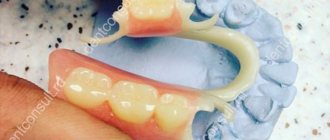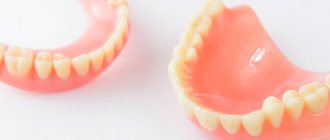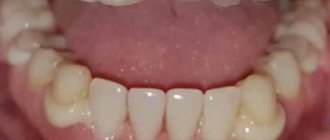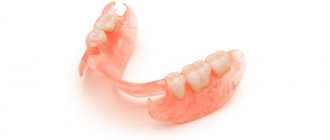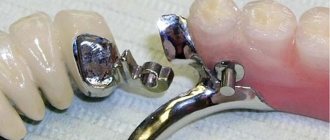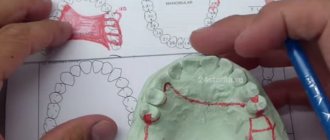Replacing lost teeth with bridges is a fairly traditional and proven prosthetic technique, used by dentists for about 30 years. Dental bridges restore chewing efficiency to 100%, practically without affecting taste, temperature and tactile sensitivity. In addition, they can completely match natural teeth in size and appearance. You can get used to the dentures almost immediately. Let's try to find out if everything is really so perfect together with the orthopedic dentist at the AktivStom clinic in Moscow, Sergei Sergeevich Voronkov.
What are cantilever dentures?
Dental bridges of various types are a popular prosthetic option for the destruction of one or more molars. It is used when several teeth in a row are damaged; it rests on adjacent crowns using metal fasteners, dental cement or other types of fixation. Modern bridges are placed on a support in the form of a cap, completely covering the damaged area.
If it is necessary to hide a visual defect on one side of the jaw, cantilever dentures are often recommended. As a fulcrum for installation, only one part is needed, the role of which is played by a stump, half-crown or a specially implanted pin. The design consists of two interconnected parts:
- directly supporting base for fixation;
- artificial crowns from the material chosen by the customer.
Externally, a cantilever prosthesis resembles a row of 2-3 teeth. When properly secured, it allows the patient to forget about discomfort for several years, chew any food, and smile confidently when talking.
Conditionally removable prosthetics
There is another way to fix dentures, which dentists call conditionally removable. This is not a temporary option - such a bridge is installed for a long time. In essence, this is the same prosthesis, but with only one intermediate part. And instead of crowns, it has lock-type fastenings.
Conditionally removable bridge prosthesis in the photo:
Such a prosthesis can be placed on natural and artificial teeth. It allows you to keep the enamel intact and is easily removed, even if the supporting tooth has not yet fallen out.
What types are there?
There are several types of cantilever structures. They differ according to the type of material from which the main part is poured:
- metal-ceramic (the most durable, can withstand heavy chewing load);
- all-metal (made from inexpensive metal alloys);
- made of zirconium dioxide (hypoallergenic).
When choosing a prosthesis, the specialist focuses on the type of attachment. Considering that there will be only one fulcrum, he needs to calculate the place of compression when the upper and lower jaws come into contact. In order for the dental system to last a long time without breakage, ceramics are not recommended for manufacturing. This material on artificial teeth looks natural, but quickly becomes covered with cracks and prohibits the consumption of solid foods.
Based on the type of fit to the gums and alveolar processes, the cantilever prosthesis is divided into two types:
- tangent;
- flushing
The first option sits tightly on the mucous membrane, so it is used only in people with absolutely healthy gums without wounds. The second type is suitable for frequent exacerbations of periodontal disease or gingivitis: it allows you to wash the inflamed areas without removing the structure using a thin hose and apply antiseptics.
How much does a dental bridge cost?
Moscow prices for bridges consist of the cost of the casts required for the manufacture of the structure, the prosthesis itself, its fitting and installation. The cost of the dental bridge itself depends, first of all, on the material used. Thus, the most budget option is plastic, but plastic structures are used only as temporary prostheses, the most expensive are all-ceramic bridges with a zirconium dioxide frame, metal-ceramics are inferior to them in cost, but practically not inferior in quality. Also, how much a dental bridge costs is influenced by the price category of the dental clinic where a dental bridge can be made in Moscow. Thus, installing the most budget bridge in economy class dentistry will cost an average of 3,000 rubles, and in a VIP clinic prices will start from 20,000 rubles for a structure consisting of two supporting crowns and one artificial tooth between them. You can find out how much it costs to install a dental bridge by reading the price list on or by calling our clinic directly. The administrator will also tell you what is included in the price and which procedures are paid separately.
Indications for installation of a prosthesis
The cantilever type of prosthesis is used for tooth decay in the front part of the jaw. It is used to reconstruct an incisor or premolar. Direct indications for restoration using a similar method:
- limited defect of 1-2 teeth;
- lack of mobility of molars, which are involved in prosthetics;
- sufficient stump height;
- replacement of one premolar to prevent displacement of the remaining teeth in the row.
This type of prosthetics is low cost, so it is recommended for patients who currently do not have the financial ability to install an implant. It has external fixings and metal fasteners, making it suitable for people with allergies.
Advantages and disadvantages of designs
The main advantage is that cantilever prostheses are distinguished by their low price and simple installation technique, during which the patient does not experience pain or discomfort. The positive aspects include quick adaptation to artificial teeth. After 10-14 days, a person forgets about the bridge, speaks without defects, and tries new dishes. A more complete picture of the positive and negative aspects of prosthetics using consoles can be obtained using the table:
| Advantages | Flaws |
| Suitable for front tooth restoration, helps create an ideal smile line. | It is not recommended for use to replace posterior crowns. The prosthesis is not designed to withstand heavy loads when closing the jaw. |
| Before installation, the lateral teeth are ground minimally, which allows them to be kept in good condition longer. | It is impossible to correctly redistribute the load, so gradually the root of the supporting tooth becomes loose and loses stability. After a few years, it may require treatment and strengthening with a pin. |
| Only one fulcrum is required (one tooth or stump). | After the destruction of the supporting molar, you will have to choose a new type of restoration; it is not suitable for the loss of more than 1 unit in a row. |
| Low cost of the prosthesis compared to implantation and other types of bridges. | There are a limited number of cases in which a cantilever design is recommended. |
| Produced in a short time. | If broken, it is practically unsuitable for repair or soldering and requires complete replacement. |
| Easy to care for daily, easy to clean at home. | If the gums under the bridge become inflamed or suppurated, it must be removed so that the dentist has access to the infected area. |
If a cantilever prosthesis is properly manufactured and installed, its service life is 5-10 years. It is practically not felt in the mouth, does not interfere with making sounds or biting off tough meat. Among the positive aspects, there is no need to remove the root of a destroyed tooth and nerve endings, so the bone tissue is not deformed, and the possibility of subsequent implantation with a metal pin remains.
Shirokov Ivan
orthopedic dentist
Important! After prosthetics with a cantilever bridge, the tooth that is chosen as the supporting one experiences double pressure when biting or clenching the jaws. It is necessary to periodically check its stability, and if it is damaged, switch to a clasp design or install a lightweight “butterfly” with fixation by two adjacent crowns.
Advantages and disadvantages
The advantages of this method of dental restoration include:
- Rapid and non-invasive restoration of appearance and chewing function.
- Quick adaptation - after 3-7 days the patient already feels the structure like his own teeth.
- The ability to choose an option that suits the price from a variety of materials for prostheses.
Flaws:
- The need to grind, and often depulpate, abutment teeth.
- Impossibility of installation in patients with periodontal disease and other contraindications.
- Possibility of development of atrophic processes in bone tissue under a bridge.
Stages of manufacturing cantilever dentures
Cantilever types of structures are produced in the laboratory by an orthodontic technician. First, special wax impressions are taken from the patient, from which a mold for casting is subsequently made. More modern dental centers design a three-dimensional model of the jaw with a perfect repetition of all defects and nuances. The aesthetics and comfort of wearing the product depend on the accuracy of this work.
Further production of cantilever prostheses takes place in several stages:
- In the laboratory, parts for the supporting structure are selected: artificial crowns, half-crowns or abutments for the pin.
- From the previously taken impression, the technician makes a model of the future prosthesis, from which he casts a base from metal ceramics or a selected “budget” alloy.
- Several layers of ceramic are sprayed onto the workpiece, thoroughly dried and polished.
- Using a milling cutter, the technician gives the base the correct shape and forms the anatomical surface of the crown.
The final stage is control fitting. The prosthesis is placed on a support and coated with a special dye. The patient clenches the jaw tightly and the colored dots indicate the correct position of the pressure points. If necessary, the protrusions are re-grinded. This is necessary so that the desire process becomes comfortable, and the sharp protrusions do not injure the tongue.
How is the installation going?
Before prosthetics, the dentist performs a complete sanitation of the patient’s oral cavity. He needs to make sure that the supporting tooth can withstand the load and does not have carious holes or chips. A thin layer of enamel is sanded off to make the surface rougher. This is necessary for better adhesion to dental glue. Sometimes a specialist recommends removing the nerve endings to reduce the risk of complications in the future. After all the manipulations, an impression is taken to cast the cantilever prosthesis.
Grinding the enamel makes the abutment tooth more sensitive to temperature changes. It hurts the client to drink hot tea or bite into a chilled product. Therefore, a plastic crown is temporarily installed, which covers the dentin and additionally protects the gums from injury.
The cantilever bridge is fixed using dental cement onto a previously degreased base of the stump. The special mass has an adhesive structure and dries quickly after application. It has a non-toxic composition containing zinc or phosphate ions, so an allergic reaction is excluded. The installation procedure is painless and does not require local anesthesia.
Are there any contraindications?
Despite the large list of advantages of cantilever prostheses, there are a number of important contraindications that impose restrictions on the use of structures:
- chronic gum disease (periodontal disease, periodontitis);
- uncontrolled bruxism;
- abnormal bite shape.
It is strictly forbidden to install a dental system if the patient has signs of cervical caries. Food particles will get clogged under the crown and will only worsen the situation, leading to complete destruction of the supporting tooth.
Operating period
Comfort when wearing a cantilever prosthesis largely determines the quality of the orthodontic technician’s work and the type of material chosen. The most durable and durable products are made from zirconium dioxide, which is resistant to corrosion and can withstand heavy loads. The average wearing period of the structure is from 5 to 10 years, provided the pressure during chewing is correctly calculated and adjacent teeth are preserved.
Careful care of the prosthesis and oral cavity helps to increase the service life. Once every six months you should visit a specialist who will examine the artificial teeth and correct the destruction of cement and displacement in a timely manner. Regular professional cleaning will prevent cervical caries and gum inflammation.
Price
The cost of dental bridges, like other dental services, largely depends on the marketing and pricing policies of a particular clinic. Also important is the material chosen by the patient. Metal ceramics will be the most affordable and will delight you with practicality. Zirconium dioxide, a representative of elite dental orthopedics, will cost more, but such a bridge will last 2-3 decades with proper care.
Average cost of installing bridges in Moscow:
- Metal ceramics from RUB 2,950. up to 16,000 rub.
- Ceramics from RUB 11,500. up to 25,000 rub.
- All-metal from RUB 2,100. up to 4,500 rub.
Care
Daily care of a cantilever prosthesis involves carefully cleaning the surface of the artificial enamel from plaque. Hygiene is carried out with a regular toothbrush and toothpaste without abrasive particles. After this, be sure to go through the thread to remove stuck food particles that cause rotting and an unpleasant odor.
After the procedure, the oral cavity should be rinsed with a disinfectant solution that contains herbal decoctions and natural oils. A good assistant for caring for any dentures is an irrigator. The compact device, using a miniature nozzle, washes away any deposits at the base of the gums, helps prevent the formation of stone, and protects against pathogenic bacteria.
How to care for bridges?
Bridge prosthetics belongs to the category of non-removable prosthetics, and therefore caring for an orthopedic structure does not involve removing it from the oral cavity for cleaning. As always, you should brush your teeth twice a day, rinse your mouth after meals, use dental floss or a waterpik, depending on your hygiene protocol. Regular visits to the dentist - twice a year - are mandatory. And without delay - if problems arise with a bridge or any other teeth.

